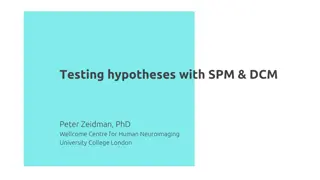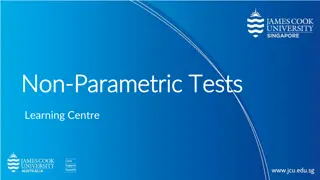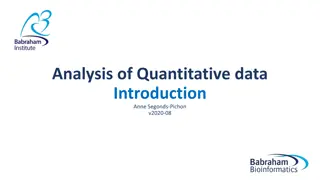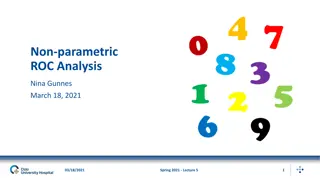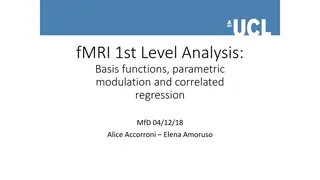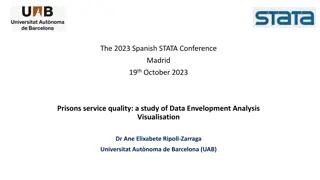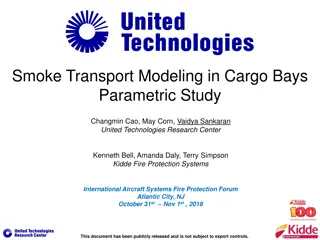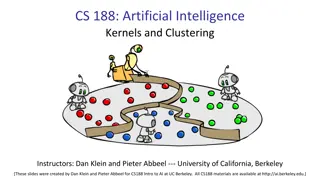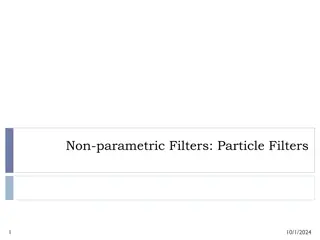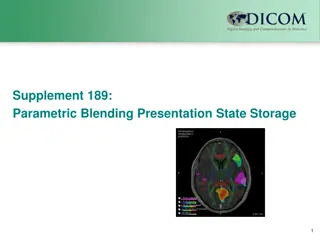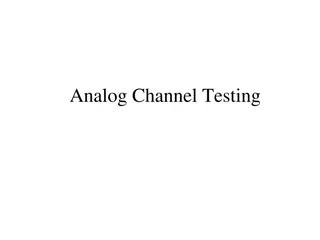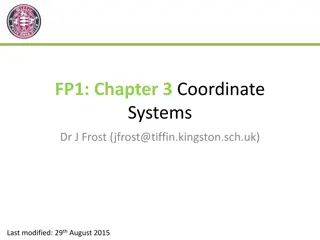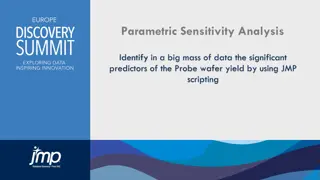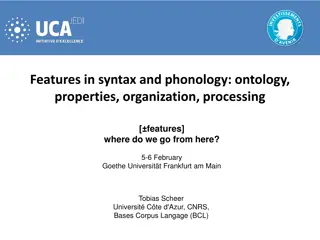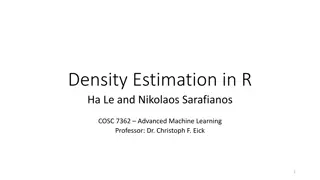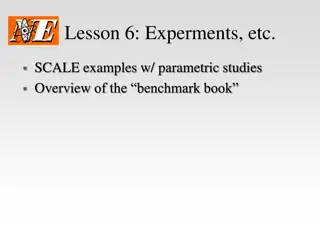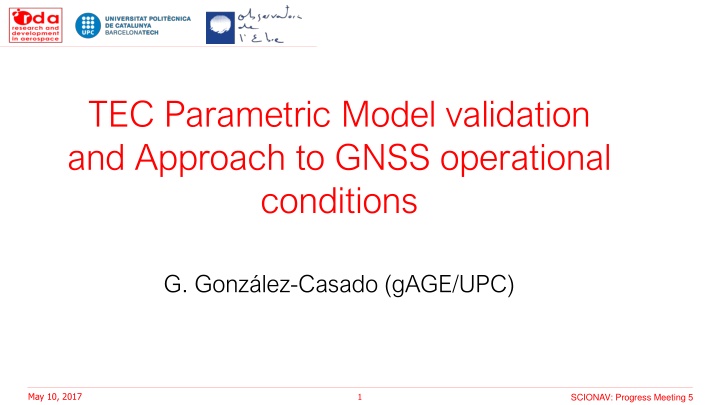
Approach to GNSS Operational Conditions: Model Validation by G. González-Casado
Explore the validation and approach to GNSS operational conditions through a parametric model analysis conducted by G. González-Casado. The study includes performance analysis, model fitting under operational conditions, and implementation and testing processes. Ground network configurations and daily model residuals are also examined.
Download Presentation

Please find below an Image/Link to download the presentation.
The content on the website is provided AS IS for your information and personal use only. It may not be sold, licensed, or shared on other websites without obtaining consent from the author. If you encounter any issues during the download, it is possible that the publisher has removed the file from their server.
You are allowed to download the files provided on this website for personal or commercial use, subject to the condition that they are used lawfully. All files are the property of their respective owners.
The content on the website is provided AS IS for your information and personal use only. It may not be sold, licensed, or shared on other websites without obtaining consent from the author.
E N D
Presentation Transcript
TEC Parametric Model validation and Approach to GNSS operational conditions G. Gonz lez-Casado (gAGE/UPC) May 10, 2017 1 SCIONAV: Progress Meeting 5
Outline: 1. Results of performance analysis for the full year 2014. 2. Performance study when model fitting is performed resembling operational conditions in the context of GNSS. A reduced set of ground stations (25) is used to determine the best-fit model parameters. Data source (STEC/VTEC) used to fit model parameters does not come from the Fast-PPP geodetic processing of GNSS signals implemented by gAGE. May 10, 2017 2 SCIONAV: Progress Meeting 5
TEC Parametric Model validation TEC Parametric Model validation May 10, 2017 3 SCIONAV: Progress Meeting 5
TEC Model implementation and testing Observations from a WW network of IGS stations (150- 160) STEC Linear Least Squares (LLS) fitting separated in 2 layers FPPP CPF geodetic processing Two-layer GIM + DCBs (sat & sta) Unambiguous LI measurements True STEC (unambiguous & DCB corrected) STEC predicted by model for the next day Model fit to TEC for each layer separately for one day Best-fit model parameters for one day Model calculations for a set of l.o.s. sat- sta rays for the next day Step 1: fit LT variation at different modips Model error (global & regional) Daily RMS of STEC differences Step 2: fit modip variation of each functionality of the model May 10, 2017 4 SCIONAV: Progress Meeting 5
Networks of ground receivers considered for the performance analysis: GLOBAL: is the full set of ground stations used by the Fast-PPP CPF to generate the true STEC used as reference for the model validation. About 160 stations world-wide distributed. EUR: subset of GLOBAL network formed by about 20 ground stations in the European region limited by longitude in the interval [ 10 , 30 ] and latitude in the interval [35 , 65 ]. BRA: subset of GLOBAL network formed by about 20 ground receivers in the South American region located in the modip range of 30 around the magnetic dip equator and in the interval of longitudes [ 95 , 30 ]. NAM: subset of GLOBAL network formed by about 15 ground stations in the USA/Canada region limited by longitude in the interval [ 125 , 60 ] and latitude in the interval [30 , 55 ]. May 10, 2017 5 SCIONAV: Progress Meeting 5
Daily RMS of model residuals for 2014 May 10, 2017 6 SCIONAV: Progress Meeting 5
Daily RMS of model residuals for 2014 May 10, 2017 7 SCIONAV: Progress Meeting 5
Comparison of STEC model errors for 2014 Klobuchar vs SCIONAV errors (% of time / # days) SCIONAV is better SCIONAV is better by > 3 TECU SCIONAV is worse SCIONAV is worse by > 3 TECU Network GLOBAL 100% 349 67% 233 0% 0 0% 0 3 TECU 50 cm of L1 BRA 97% 340 77% 267 3% 9 0% 0 EUR 97% 340 39% 136 3% 9 0% 0 NAM 83% 291 21% 75 17% 58 0.5% 2 NeQuick vs SCIONAV errors (% of time / # days) SCIONAV is better SCIONAV is better by > 3 TECU SCIONAV is worse SCIONAV is worse by > 3 TECU Network GLOBAL 81% 282 22% 77 19% 67 0% 0 BRA 91% 317 58% 204 9% 32 0% 0 EUR 71% 246 11% 38 29% 103 0.3% 1 NAM 56% 195 5% 19 44% 154 0% 0 May 10, 2017 8 SCIONAV: Progress Meeting 5
Main conclusions of comparing errors in STEC predictions for 2014: At a global scale, the SCIONAV parametric model (SPM) improves the ionospheric models used by GPS and Galileo, clearly reducing the error in the STEC predictions. Compared to Klobuchar, the improvement of SPM is regular and very similar in the 3 regions analyzed. Only slightly smaller in the USA/Canada region. Compared to NeQuick, the improvement of SPM is quite irregular. Larger improvements are achieved for the low modip region in South America but the improvement is small in the USA/Canada region. Looking to significant reduction of STEC errors (> 3 TECU or 50 cm of L1), the SPM achieves a relevant reduction more than 60-70% of the time in the low modip region (BRA) when compared to the GNSS models. Compared to Klobuchar, significant error reduction by the SPM is still important in mid-latitude regions (EUR and NAM), but compared to NeQuick that reduction is not very frequent (5-10% of the time). However, looking to significant increase of STEC errors by the SPM, they are essentially never found in any of the regions analyzed (neither globally) compared to the GNSS models during 2014. May 10, 2017 9 SCIONAV: Progress Meeting 5
Still pending validation of SPM for other years. Performance of SPM will be analyzed for the following periods: 2015 [100, 110], [130, 140]. Total 22 days. 2007 [135, 150] and 2006 [335, 350]. Total 32 days. Solar minimum. 2002 [130, 144] and 2003 [295, 310]. Total 31 days. Solar maximum. For 2015 we can repeat the game played for 2014. Two-layer VTEC maps similar to those used for 2014 exist. But for the other years, very small number of equatorial IGS stations. Fitting based in VTEC maps does not work for low modip regions. Solution: try model fit based on STEC directly (see second part of this talk). May 10, 2017 10 SCIONAV: Progress Meeting 5
Testing Approach Testing Approach to GNSS operational to GNSS operational conditions conditions May 10, 2017 11 SCIONAV: Progress Meeting 5
Broad Broad description of the description of the tests performed tests performed SCIONAV parametric model is fixed in all the cases. Different data sources have been considered to fit the model parameters. 1. FPPP: all sta unambiguous LI obtained after the Fast-PPP processing. Where all sta means that about 160 stations world-wide distributed provide source measurements to build the GIMs. The original fitting method used up to now. Uses a two-layer gAGE GIM based on 2. LI PI: all sta which is derived after using the code-carrier phase alignment to estimate ambiguities. Model fit is the same as in (1) but uses an alternative two-layer GIM (less precise) The geodetic processing of the FPPP CPF is not applied in this case. 3. FPPP: 25 sta STEC being calculated using the FPPP CPF, i.e., the true STEC used as reference to evaluate the performance of all models in this project. Model fit using directly the STEC separated in two layers from a set of 25 stations. 4. LI PI: 25 sta (2) instead of the true STEC calculated by the FPPP CPF. Model fit is the same as in (3), but using the less precise STEC values obtained in case May 10, 2017 SCIONAV: Progress Meeting 5
Distribution of the 25 stations used in FPPP: 25 Distribution of the 25 stations used in FPPP: 25 sta sta and LI and LI- -PI: 25 PI: 25 sta sta The network of 25 stations selected for the tests 3 and 4 tried to reproduce a world-wide distributed network of Galileo Sensor Stations (GSS) plus some additional stations. Model fits were performed using data from two weeks in 2014: DOYs from 86 to 92, near March Equinox. DOYs from 200 to 206 in July. May 10, 2017 13 SCIONAV: Progress Meeting 5
Comparison of daily RMS of STEC errors from each model fit Summer week Equinox week May 10, 2017 14 SCIONAV: Progress Meeting 5
Comparison of hourly RMS of STEC errors from each model fit In the two periods of time analyzed the different model fits achieve a similar precision in their STEC predictions. The largest degradation in the performance of STEC predictions achieved by the new fitting methods (with regard to the original fitting method) is smaller than 1.5 TECU. In the summer period the difference between the errors is always within 1 TECU. This is also true for the Equinox week during 98 % of the time for the model fits based on LI PI, and during 90% of the time for the model fit FPPP 25 sta. Errors evaluated over the Global network: The largest degradation in the model performance when using the new fitting methods is found within the Equinox week for the BRA network (around the magnetic equator). Occasionally, the degradation in the performance with the new fitting methods can reach more than 3 TECU. But in the worse case, this happens during not more than 10% of the time (for the full week). Errors evaluated over the regional networks of stations: May 10, 2017 15 SCIONAV: Progress Meeting 5
Comparison of hourly RMS of STEC errors from each model fit Percentage of time of worse performance of the new fitting methods wrt the original method (FPPP: all sta) during the Equinox week % of time in one week: BRA network % of time for the USA/Canada region Degradation > 1.5 TECU Degradation > 3 TECU Degradation > 1.5 TECU Degradation > 3 TECU Fit method Fit method FPPP: 25 sta 21 % 5 % FPPP: 25 sta 11 % 2 % LI-PI: all sta 30 % 8 % LI-PI: all sta 0.6 % 0 % LI-PI: 25 sta 30 % 9,5 % LI-PI: 25 sta 12 % 0 % May 10, 2017 16 SCIONAV: Progress Meeting 5
Main conclusions: Within the limited scope of the study (only 2 weeks), the results obtained seem to support an operational implementation of the SPM which does not require the Fast-PPP geodetic processing of GNSS measurements. Moreover, the use of STEC data from a large number of ground stations is not necessary to determine the model parameters. In principle, 25 stations adequately distributed seem to be sufficient to avoid a relevant degradation in the model performance. NOTE: by the moment, the data set for model fitting (either STEC or VTEC) must be provided separated in two layers. May 10, 2017 17 SCIONAV: Progress Meeting 5
Comparison of hourly RMS of STEC errors from each model fit May 10, 2017 18 SCIONAV: Progress Meeting 5

